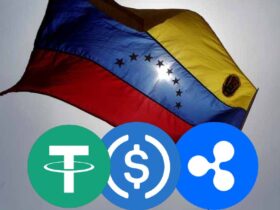The presidential pardon for CZ favors the image of Binance and, therefore, BNB.
Institutional investments in BNB could boost its price.
United States President Donald Trump, from the White House, extended a presidential pardon to Changpeng Zhao, the founder of the Binance exchange known as CZ.
It is a movement that not only seeks erase the shadows of a trial that dated back to the Biden erabut rather frees an entrepreneur from restrictions and accelerates a rethinking where the BNB cryptocurrency—created by the Binance exchange—emerges as the common thread of an expanding ecosystem.
Analysts like Mike Fay, who follow the pulse of these networks, come on this turn an opportunity for BNB Chain’s native digital asset to regain lost ground.
Fay, in his recent review of the investment thesis, directly connects the pardon with a revitalization of Binance’s image. “It’s time to re-analyze network fundamentals now that Binance founder CZ has been pardoned by President Trump,” says the market specialist.
this forgiveness dissipates regulatory clouds that had weighed on the platform since 2023. Zhao faced charges in November of that year, brought by the Criminal Division of the United States Department of Justice.
They accused him of violating the Bank Secrecy Act (BSA), a legal framework that brings together regulations to prevent money laundering and terrorist financing. Binance, under his leadership, failed to implement an effective program against these practices, according to prosecutors.
Centralization, the Achilles heel of BNB Chain
However, Fay’s optimism does not ignore structural cracks. “I have always maintained that BNB Chain has a considerable risk of centralization in governance compared to other layer 1 networks such as Ethereum,” the analyst details.
This concern lies in the very architecture of the network. BNB Chain operates with a much smaller number of validators than its competitors. In fact, the top eight control over 40% of the staked BNB, concentrating power in few hands and exposing the network to potential manipulations.
Ethereum, by contrast, distributes its validation across thousands of nodes, fostering a decentralization that many see as a pillar of trust.
The cryptocurrency has climbed more than 60% since January 2025, far outperforming peers such as ether (ETH) or solana (SOL). This bullish trajectory culminated in early October, when BNB crossed the $1,200 threshold for the first time and hit an all-time high of $1,300, as seen in the following graph.
BNB Chain has an ecosystem that accelerates transactions
Beyond the judicial headlines, usage data reveals a network that is gaining daily traction. Fay compares BNB Chain primarily to Ethereum, its closest contextual peer. Although Ethereum triples the market cap of BNB, no other Layer 1 network comes as close in circulating value to ETH as BNB does. This proximity invites close scrutiny of operational metrics.
Daily transactions mark a clear advantage for BNB Chain. The network currently processes over 22 million trades per day, a volume that dwarfs Ethereum in absolute terms. Not only does it exceed nominal numbers; shows an upward trend.


Throughout 2025, Daily transactions on BNB have grown substantially, even surpassing the peak of the previous cycle. Ethereum, on the other hand, remains aligned with its past highs, without the same explosive momentum. While Ethereum has achieved stability in its usage over the past five years—growing primarily through secondary layers—BNB Chain exhibits a pattern of accelerated adoption.
This vigor is reflected in daily active addresses (DAA), an indicator that measures the number of addresses on the network that perform tasks such as signing or sending transactions. In September, BNB Chain recorded an average of 2.4 million DAAa level that underlines its vitality compared to the slower maturity of Ethereum.


BNB Chain loses on TVL and RWA with Ethereum
Even with these advances, Ethereum retains its dominance in key indicators of financial maturity. Total value locked (TVL) offers a clear example. Ethereum leads the market with a 62.9% share of global TVLa metric that quantifies funds deposited in decentralized finance protocols. Solana even surpasses BNB in this category, leaving the Binance chain in a secondary position.


The gap widens in the real-world assets (RWA) segment, where Ethereum captures slightly more than 53% of the market. BNB Chain, for its part, keeps only 2.7%. This disparity persists even when considering Ethereum’s scaling layer ecosystem, which includes three additional networks where ETH maintains greater influence on RWA than BNB in total.
In stablecoins, BNB Chain is in fourth place with $14 billion in supply, behind Solana, Tron, and the ubiquitous Ethereumwhich dominates with more than half of the share. However, one piece of information counters this narrative: active addresses in stablecoins.
BNB Chain has led this indicator in eight of the nine months of 2025. In September, 11 million addresses interacted with stablecoins on the network, tripling Ethereum’s 3 million. This traffic suggests everyday utility that transcends total volume, driven by low commissions and speed.
“If you can get past what I think are legitimate concerns about centralization on BNB, it’s hard to argue with the network’s usage growth story,” Fay concedes. He reiterates his “hodl” recommendation for BNB, but adds that he is evaluating higher exposure at the right price. The catalyst for CZ forgiveness, described as “positive news for Binance”, tips the balance towards optimismsays Fay.
CZ washed his name
Jan Domínguez, cryptocurrency consultant, shares perspectives in dialogue with CriptoNoticias. “You have to be attentive to everything that is linked to Binance because now with CZ, it has practically washed its name,” he says.
The specialist also talked about rumors circulating about Zhao’s return to Binancealong with developments such as the creation of a Kyrgyzstan central bank digital currency (CBDC) on BNB Chain. “So I think it will be positive, obviously for CZ, for Binance and for BNB,” says Domínguez.


The month of October reinforces this vision. BNB posted a positive performance, with the market digesting CZ’s reprieve as bullish momentum. Coinbase and Robinhoodtwo exchange and brokerage giants, recently listed the digital asset, a move that the market has already discounted in prices. These additions expand access, attracting retail users and paving the way for greater flows.
Institutional investments may be the next catalyst
Domínguez extends his gaze to the institutional horizon. Digital assets like ETH and XRP are already capturing the attention of funds and corporations.
“BNB will definitely also be in those objectives of those institutional markets,” he says. Large investors evaluate BNB for portfolios, considering instruments such as exchange-traded funds (ETFs) or corporate treasuries. “Everyone will be impacted to a greater or lesser extent according to the market’s perception of them and the structure that can be made of possible instruments,” he details.
The pardon opens doors to expand operations in the United States, integrating BNB into institutional flows. These investments could boost the price, as Fay anticipates, by injecting liquidity and legitimacy.
The investment firm REX Shares, in collaboration with Osprey Funds, took a step in that direction, when it filed an N-1A registration statement with the United States Securities and Exchange Commission (SEC) in August to launch a BNB-based exchange-traded fund (ETF).
Risks in a market that does not forgive mistakes
Even with these favorable winds, Domínguez highlights the importance of maintaining caution. “Investments in crypto assets are highly risky, it is a highly volatile market.” The entry of institutional actors and governments can raise prices, but it does not eliminate turbulence.
Fay closes his thesis in harmony: pardoning CZ favors the image of Binance and, by extension, BNB. Together with undeniable network growth, these elements form a catalyst. In an ecosystem where transactions and active addresses tell stories of adoption, BNB is positioned not only as an asset, but as a reflection of post-regulatory resilience.






Leave a Reply